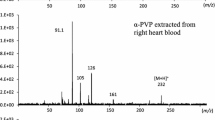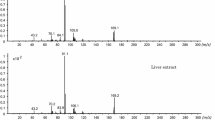Abstract
The toxicological significance of paraquat concentrations in paraquat poisonings was evaluated by means of multivariate analysis methods. Paraquat could be determined by a newly developed procedure, which involved thin-layer chromatography with flame ionization detector (TLC-FID) and solid-phase extraction with a disposable octadecylsilane cartridge. This new method proved to be simple, rapid and reliable for the analysis of paraquat in our seven cases of suicidal poisoning. The relationship between plasma paraquat concentration (C) and time from ingestion (T) could be best described by the following functions. The regression equation of fatal cases was ln[ln(Cx1000)]=2.5453-0.2114 lnT. The regression equation of survivors was ln[ln(Cx1000)] =2.1041-0.2826 lnT. The discriminant function (D) to separate the fatal and survival cases was D= 1.3114-0.1617 lnT−0.5408 [In(Cx1000)] (fatal cases: D<0, survivors: D>0). The discriminant function was demonstrated to have a high reliability for the toxicological significance in our seven poisoned patients. The significant correlation between plasma paraquat concentration and urine paraquat concentration (C) in our cases was obtained. The regression equation was lnC=0.953 lnC+1.409. This also indicated that urinary concentrations are 3.3–4.5 times greater than plasma concentrations. The multiple regression equation among plasma paraquat concentration, time from ingestion, and the ingested volume (V) of Gramoxone® (trade name of paraquat), was lnC=0.009V−0.232T+3.612.
It is suggested that the determination of paraquat is of great value, and that these data are useful in assessing the severity and predicting the outcome of poisoning for forensic and clinical purposes.
Similar content being viewed by others
References
Abou-Donia MB, Komeil AA (1978) Sequential thin-layer chromatography of paraquat and related compounds. J Chromatogr 152: 585–588
Ackman RG (1981) Flame ionization detector applied to thin-layer chromatography on coated quartz rods. Methods Enzymol 72: 205–252
Berry DJ, Grove J (1971) The determination of paraquat (1,1′-dimethyl-4,4′-bipyridylium cation) in urine. Clin Chim Acta 34: 5–11
Bismuth C, Garnier R, Dally S, Fournier PE (1982) Prognosis and treatment of paraquat poisoning: A review of 28 cases. J Toxicol Clin Toxicol 19: 461–474
Bonini M, Saux MC, Larcebau S (1973) Dosage du paraquat dans les milieux biologiques. Eur Toxicol 4–5: 237–239
Bus JS, Aust SD, Gibson JE (1974) Superoxide- and singlet oxygen-catalyzed lipid peroxidation as a possible mechanism for paraquat toxicity. Biochem Biophys Res Commun 58: 749–755
Bus JS, Aust SD, Gibson JE (1975) Lipid peroxidation: A possible mechanism for paraquat toxicity. Res Commun Chem Pathol Pharmacol 11: 31–38
Calderbank A, Yuen SH (1965) An ion-exchange method for determining paraquat residues in food crops. Analyst 90: 99–106
de Zeeuw RA, van der Laan PEW, Greving JE, van Mansvelt FJW (1976) Analysis of quaternary ammonium compounds by ion-pair thin layer chromatography. Anal Lett 9: 831–838
Draffan GH, Clare RA, Davies DL, Hawksworth G, Murray S, Davies DS (1977) Quantitative determination of the herbicide paraquat in human plasma by gas chromatographic and mass spectrometric methods. J Chromatogr 139: 311–320
Fatori D, Hunter WM (1980) Radioimmunoassay for serum paraquat. Clin Chim Acta 100: 81–90
Franke G, Pietrulla W, Preußner K (1979) Quantitative determination of paraquat in urine and serum by differential pulse polarography. Z Anal Chem 298: 38–42
Frelon JH, Merigot P, Garnier R, Bismuth C, Efthymiou ML (1983) Prognostic factors of acute paraquat poisoning. Retrospective study of the cases collected in 1981 at the Poison Control Center of Paris. Toxicol Eur Res 5: 163–169
Gill R, Qua SC, Moffat AC (1983) High-performance liquid chromatography of paraquat and diquat in urine with rapid sample preparation involving ion-pair extraction on disposable cartridges of octadecyl-silica. J Chromatogr 255: 483–490
Grone HD, Smith EM (1973) A rapid method of thin-layer chromatography to aid the identification of quaternary nitrogen drugs. J Chromatogr 77: 234–236
Haley TJ (1979) Review of the toxicology of paraquat. Clin Toxicol 14: 1–46
Harsanyi L, Nemeth A, Lang A (1985) Group intoxication with Gramoxone (Paraquat): Toxicological and pathohistological aspects. Arch Toxicol Suppl 8: 284
Irabu N (1984) Paraquat poisoning in Japan. J Jpn Municipal Hosp Assoc 198: 76–89
Itoh T, Tanaka M, Kaneko H (1980) Flame ionization detection system for thin layer chromatography of lipids. In: Touchstone JC (ed) Thin layer chromatography: Quantitative environmental and clinical applications. John Wiley and Sons Inc., New York, pp 536–552
Jarvie DR, Stewart MJ (1979) The rapid extraction of paraquat from plasma using an ion-pairing technique. Clin Chim Acta 94: 241–251
Kawano Y, Audino J, Edlund M (1975) Analysis of paraquat formulations by liquid chromatography. J Chromatogr 115: 289–292
Knepil J (1977) A short, simple method for the determination of paraquat in plasma. Clin Chim Acta 79: 387–390
Levitt T (1977) Radioimmunoassay for paraquat. Lancet II: 358
Levitt T (1979) Determination of paraquat in clinical practice using radioimmunoassay. Proc Anal Div Chem Soc 16: 72–76
Miller JJ, Sanders E, Webb D (1979) Measurement of paraquat in serum by high-performance liquid chromatography. J Anal Toxicol 3: 1–3
Mofenson HC, Greensher J, Caraccio TR, Dagostino R (1982–1983) Paraquat intoxication: Report of a fatal case. Discussion of pathophysiology and rational treatment. J Toxicol Clin Toxicol 19: 821–834
Morita Y (1974) Shin-tokei-gairon, 3rd edition. Nippon Hyoron Sha, Tokyo, pp 56–97
National Research Institute of Police Science (1968–1986) Circumstances of drug and toxic chemical poisoning in Japan (in Japanese, translated by the author). National Research Institute of Police Science, Tokyo, vol 10–28
Needham L, Paschal D, Rollen ZJ, Liddle J, Bayse D (1979) Determination of paraquat in marijuana by reversed-phase paired-ion high performance liquid chromatography. J Chromatogr Sci 17: 87–90
Niwaguchi T (1982) Drugs and toxic substances in recent forensic chemistry. Eisei Kagaku 28: 184–194
Okonek S, Hofmann A, Henningsen B (1976) Efficacy of gut lavage, hemodialysis, and hemoperfusion in the therapy of paraquat or diquat intoxication. Arch Toxicol 36: 43–51
Okonek S, Weilemann LS, Majdandzic J, Setyadharma H, Reinecke HJ (1982–1983) Successful treatment of paraquat poisoning: Activated charcoal per os and continuous hemoperfusion. J Toxicol Clin Toxicol 19: 807–819
Okumura T (1980) Sintered thin-layer chromatography. J Chromatogr 184: 37–78
Paschal DC, Needham LL, Rollen ZJ, Liddle JA (1979) Determination of paraquat in sunflower seeds by reversed-phase highperformance liquid chromatography. J Chromatogr 177: 85–90
Proudfoot AT, Stewart MS, Levitt T, Widdop B (1979) Paraquat poisoning: Significance of plasma-paraquat concentrations. Lancet II: 330–332
Pryde A, Darby FJ (1975) The analysis of paraquat in urine by high-speed liquid chromatography. J Chromatogr 115: 107–116
Queree EA, Dickson SJ, Shaw SM (1985) Extraction and quantification of paraquat in liver and hemolyzed blood. J Anal Toxicol 9: 10–14
Scherrman JM, Galliot M, Garnier R, Bismuth C (1983) Intoxication aigue par le paraquat: intérêt pronostique et thérapeutique du dosage sanguin. Toxicol Eur Res 5: 141–145
Stewart MJ, Levitt T, Jarvie DR (1979) Emergency estimations of paraquat in plasma. A comparison of the RIA and ion pair colorimetric methods. Clin Chim Acta 94: 253–257
Tadjer GS (1967) The identification of paraquat in biological material using thin-layer chromatography. J Forensic Sci 12: 549–553
Teare RD (1976) Poisoning by paraquat. Med Sci Law 16: 9–12
The 75th AOCS Annual Meeting (1985) The symposium on analyses by Iatroscan TLC/FID system. Lipid 20: 501–560
Tompsett SL (1970) Paraquat poisoning. Acta Pharmacol Toxicol 28: 346–358
Toyokawa H, Yanai H (1982) Statistics, 1st edition. Gendai-sugakusha, Kyoto, pp 48–86
Tsunenari S (1975) The determination of paraquat using thin-layer chromatography. Forensic Sci 5: 61–67
Ukai S, Hirose K, Kawase S (1973) Determination of diquat and paraquat in aqueous herbicide preparations by gas chromatography. J Hyg Chem 19: 281–286
Ukai S, Hirose K, Kawase S (1977) Gas chromatography of reduction-products of herbicide diquat and paraquat with sodium borohydride-transition metal salt. J Hyg Chem 23: 32–38
Ukai S, Kawase S (1985) Paraquat poisoning and forensic chemistry. Eisei Kagaku 31: 283–297
van den Bogaerde J, Schelstraete J, Colardyn F, Heyndrickx A (1984) Paraquat poisoning. Forensic Sci Int 26: 103–114
van den Heede M, Heyndrickx A, Timperman J (1979) A fatal intoxication due to paraquat intake without any specific treatment. J Pharm Belg 34: 69–76
van den Heede M, Heyndrickx A, Timperman J (1982) Thin layer chromatography as a routine appropriate technique for the determination of bipyridylium herbicides in post mortem human tissues. Med Sci Law 22: 57–62
van Dijk A, Maes RAA, Drost RH, Douze JMC, van Heyst ANP (1975) Paraquat poisoning in man. Arch Toxicol 34: 129–136
van Dijk A, Ebberink R, de Groot G, Maes RAA, Douze JMC, van Heyst ANP (1977) A rapid and sensitive assay for the determination of paraquat in plasma by gas-liquid chromatography. J Anal Toxicol 1: 151–154
Watari M, Kishi M (1984) Multivariate analysis program, revised edition. Kogaku Tosho Inc., Tokyo, pp 23–66
Yanai H, Takane Y (1985) Multivariate analysis, revised edition. Asakura company, Tokyo, pp 66–85
Yuen SH, Bagness JE, Myles D (1967) Spectrophotometric determination of diquat and paraquat in aqueous herbicide formulations. Analyst 92: 375–381
Author information
Authors and Affiliations
Additional information
Dedicated to Prof. Dr. K. Okada and Prof. Dr. S. Kotoku on the occasion of their 60th birthdays
Rights and permissions
About this article
Cite this article
Ikebuchi, J. Evaluation of paraquat concentrations in paraquat poisoning. Arch Toxicol 60, 304–310 (1987). https://doi.org/10.1007/BF01234670
Received:
Accepted:
Issue Date:
DOI: https://doi.org/10.1007/BF01234670




